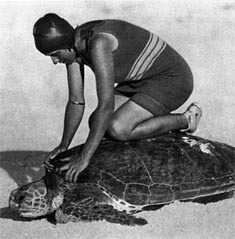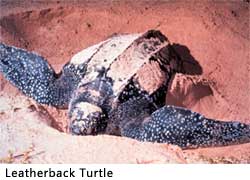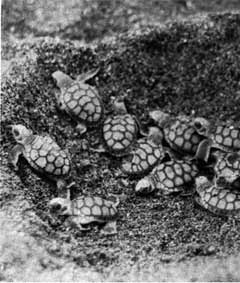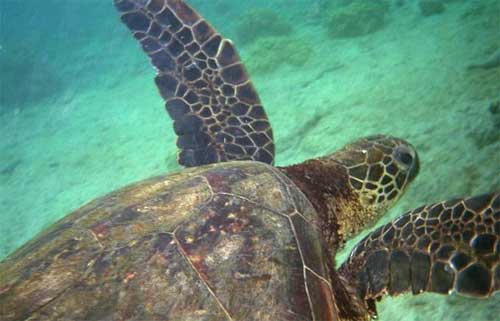|

 Big Boys: The Leatherback Sea Turtle is the largest, measuring six or seven feet (2 m) in length at maturity, and three to five feet (1 to 1.5 m) in width, weighing up to 1300 pounds (600 kg). Big Boys: The Leatherback Sea Turtle is the largest, measuring six or seven feet (2 m) in length at maturity, and three to five feet (1 to 1.5 m) in width, weighing up to 1300 pounds (600 kg).
Most other species are smaller, being two to four feet in length (0.5 to 1 m) and proportionally less wide. There are seven types of sea turtles: Kemp's Ridley, Flatback, Green, Olive Ridley, Leatherback, Loggerhead, and Hawksbill.
The Leatherback Sea Turtle (Dermochelys coriacea) is the biggest of all living turtles, reaching a length of over 2.7 m (8 ft) and weight of 900 kg (1,500 lb). The Leatherback Sea Turtle is found in all tropic and subtropic oceans. It is the only extant species in the genus Dermochelys and the family Dermochelyidae.
One Special Turtle: This species has many unique features that distinguish it greatly from other sea turtles. Its shell lacks the bony scutes of other turtles, comprising mainly connective tissue. Its metabolic rate is about 3 times higher than one would expect for a reptile of its size; this, coupled with counter-current heat exchangers, the  insulation provided by its oily body and large size, allow it to maintain a body temperature as much as 18 °C (64 ºF) above that of the surrounding water. insulation provided by its oily body and large size, allow it to maintain a body temperature as much as 18 °C (64 ºF) above that of the surrounding water.
Some scientists hypothesize that the Leatherback might have some capacity to generate its own body heat (like a mammal), although reptiles in general have been defined as ectotherms ("cold-blooded") and are thought not to be able to do so.
Peanut Butter and Jellyfish: The beak of the Leatherback turtle is specially hooked to help it bite jellyfish and its throat has backward-facing barbs to help it swallow them. These throat hooks have caused Leatherbacks problems - they swallow plastic bags, which look like the gelatinous animals they prey on, and these indigestible bags then clog up their throats, preventing them feeding and eventually killing them. Dead leatherbacks have been found with plastic bags, pieces of hard plastic, and monofilament fishing line in their stomachs.

Who Needs a Map? Sea turtles have an extraordinary sense of time and location. They are highly sensitive to the Earth's magnetic field and probably use it to navigate. They live up to 189 years. The fact that most species return to nest at the locations where they were born seems to indicate an imprint of that location's magnetic features.
 The Ridley turtles are especially peculiar because instead of nesting individually like the other species, they come ashore in one mass arrival known as an "arribada" (arrival). With the Kemp's ridley this occurs during the day and on only one beach in the entire world. Their numbers used to range in the thousands but due to the effects of extensive egg poaching and hunting in previous years the numbers are now in the hundreds. The Ridley turtles are especially peculiar because instead of nesting individually like the other species, they come ashore in one mass arrival known as an "arribada" (arrival). With the Kemp's ridley this occurs during the day and on only one beach in the entire world. Their numbers used to range in the thousands but due to the effects of extensive egg poaching and hunting in previous years the numbers are now in the hundreds.
Birds and Bees: After about 30 years of maturing, adult female Sea turtles return to the land to nest, usually on the same beach from which they hatched. This can take place every two to four years in maturity.
They make from four to seven nests per nesting season. They dig a hole with their hind flippers and lay from 70 to 170 eggs in it (depending on the species) before covering it up and returning to the ocean.
Tiny Turtle Troubles: Some of the eggs are unfertilized 'dummy eggs' and the rest contain young turtles. Incubation takes about 2 months. When the eggs hatch, these baby turtles dig their way out and seek the ocean. Only a very small proportion of them (at most 1 in 100) will be successful, as many predators are waiting to eat them.

All text is available under the terms
of the GNU Free Documentation License
|